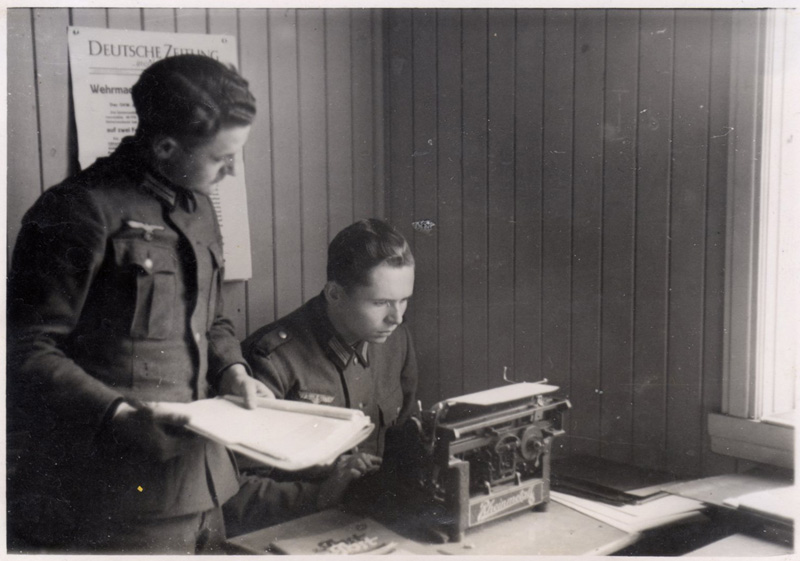
The German military generated a vast amount of paperwork on every level. From the highest commands down to each individual Kompanie, there were soldiers tasked with handling this tremendous quantity of records and documents. The Kompanie (or its equivalent) was the smallest basic element of most Wehrmacht units. In a wartime infantry unit, a Kompanie, generally speaking, was formed of 3 platoons and a staff. Each Kompanie had an office, a Schreibstube, which by regulation was commanded by a Hauptfeldwebel, and had 3 clerks (Schreiber), each of whom had his own discrete duties and responsibilities. That was the historical reality.
WWII reenacting is in many ways at odds with history, particularly when it comes to scale. Few if any reenactment groups ever approach Kompanie size, and no unit I am aware of has ever had someone portraying every role in a Kompanie. Most units are relatively small and typically field in squad or platoon strength. To staff a Schreibstube in the regulation way, with 4 people working together to oversee records and handle correspondence, is impractical in most reenactment units; smaller numbers generate fewer paperwork requirements than the real-world clerks had to contend with. Having said that, every unit, no matter how small, needs someone who can complete and issue identity paperwork and award documents. And even if you aren’t in a unit, if you have Schreiber skills you may find your services to be in very high demand at events you may attend. Correct personal paperwork is an integral part of a soldier’s kit. Having the proper paperwork is every bit as important as having the proper weapon or headgear. The Schreiber is an indispensable impression for living history.
Creating a Schreiber impression is a challenge. The learning curve is steep and making convincing recreation documents requires a level of technical skill that can only come with practice. The very first step, even before picking up a fountain pen, should be to study the Soldbuch, the personal identification document and paybook that every German soldier carried. This document, which is a complex booklet with many intricacies, is the core of personal paperwork needed by every military reenactor. You must study this book until you know it inside and out, you must know the meaning not only of each page but each individual word. As a Schreiber in reenacting, you will be expected to be able to fill out and update a Soldbuch as needed. You need to look at a Soldbuch as a blank form that you need to complete. The men in your unit, or at the event you are at, are going to be coming to you with information to use to fill out this form. In order to do this correctly, first of all, you need to know what information goes in the Soldbuch, and what doesn’t. For the information that goes in there, you are going to need to be able to translate it, and master the countless variables to identify the correct entry for every section. There is work and study involved here. A reenactor can buy a rifle and be a rifleman, but a Schreiber needs to have a good amount of specialized knowledge to do justice to his impression. He needs to know exactly what the designation is for his unit and how it may have changed over time. He needs to know the training unit or units that supplied recruits to the unit his group portrays. He needs a large vocabulary of German terms in order to understand what goes where and to write each entry correctly. An advanced Schreiber can handle complex demands. How would a Soldbuch look for a soldier who transferred from one branch of the military to another? What about a Soldbuch for a Germanic volunteer from outside Germany? Nobody can ever know all there is to know about the Soldbuch. Fortunately, there are literally thousands of Soldbuch scans freely available on the Internet. Handling original examples may be helpful but it is not required. Study original books until you are able to look at any Soldbuch and interpret every entry.
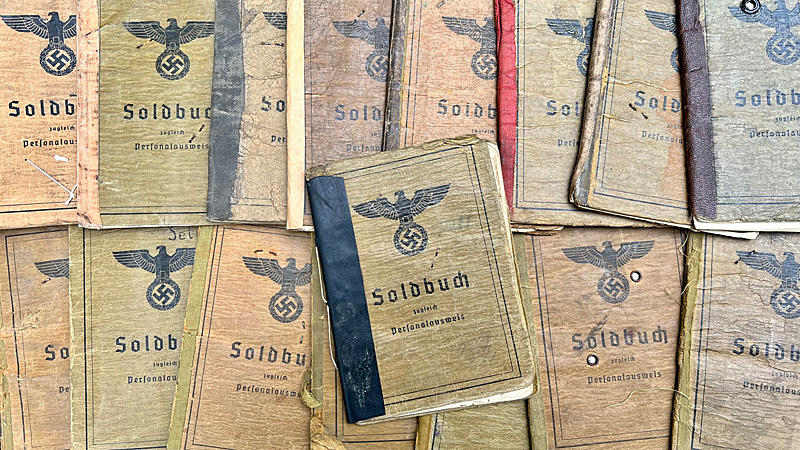
Once you have a working knowledge of the Soldbuch, you can take the first steps in getting ready to fill them out. You are going to need tools: pens, ink and rubber stamps. A Soldbuch that was carried for years generally would have entries made by different people over time, and to recreate this look you are going to have to learn different handwriting styles. Three scripts commonly used in the Nazi-era in Germany were Sütterlin, Kurrent and Deutsche Normalschrift. Deutsche Normalschrift is similar to modern cursive but it is nevertheless very distinctive. Sütterlin and Kurrent are old forms of Gothic handwriting that have fallen into disuse, they are the handwriting equivalent to Fraktur typography. In my opinion, for our purposes, the Sütterlin is the most important and is the best place to start. Once you have mastered that you can conquer the others. The letters used in Sütterlin and Kurrent are largely the same (Sütterlin is more rounded, and vertical, while Kurrent has longer ascenders and descenders) but Sütterlin is meant to be written with a round-tipped pen and Kurrent with an italic nib- sometimes sold as a calligraphy pen, or a “Bandzug” nib in German. Having the right tools makes all the difference and the writing instrument is important in this type of writing.
The standard disposable writing instruments in the Third Reich were pencils and dip pens. Indelible pencil, called Kopierstift, was often used for signatures that authorized various entries. These are still made today by Faber-Castell and other brands, sometimes called “document” pencils. The look of indelible pencil can be reasonably duplicated by using a purple colored pencil. Dip pens are very easy to find. Vintage pens and unused nibs can be found on online auction sites and elsewhere, and newly-made pens are offered by many sellers of art supplies. Using dip pens with a variety of nibs is the cheapest and simplest way to make sure that the various entries in a Soldbuch show realistic-looking variation. I use dip pens often when completing reproduction documents. The vintage nibs are often very flexible and this allows you to use pressure to vary line width while writing, this creates a realistic look. Some modern nibs have a similar amount of springiness- I like to use nibs made by Brause in Germany.
Fountain pens were widely used. They were personal, and rather expensive. Vintage fountain pens from that era can still readily be found. Many vintage pens now have issues and require attention from someone skilled in the repair and maintenance of old pens- but even then, these antiques can be leaky or have other idiosyncracies. They are also often small by modern standards. A fountain pen uses a metal nib to convey liquid ink to paper. Modern fountain pens write the same way as the period originals and will create writing that can be indistinguishable from period script. I regard modern pens as a good choice for getting started. One modern pen that I recommend is called the Kaweco Sport. It is still made in Germany, this model was introduced in 1934 and was marketed to Wehrmacht soldiers. The current-production version of this pen is very similar to the 1940 version, the main differences are that the 1940 version was a piston filler (different mechanism inside), it was made out of “Ebonite” plastic instead of nylon or whatever the new pen is made out of, and it had an engraved texture on parts of the outside, called “guilloch.” The basic proportions and overall look, though, have remained basically the same; even the logo is the same. Another modern pen I love is the Pelikan Tradition M200. Modern Pelikan pens are different from wartime Pelikans but only a fountain pen enthusiast would be likely to pick up on this as the styling in general is not really so very different from a generic pre-war period German piston filler. This is as close as I have been able to get get to a brand new celluloid German piston filler of the 40s being manufactured today and it is a dependable pen that is perfect for daily use. The Kaweco Sport is available with a 1.1mm italic nib that is great for writing Kurrent. Pelikan also makes a cheap pen with a similar italic nib, the Pelikan Script. Changing the angle of an italic nib before you start writing changes the appearance of the handwriting, this is a great feature for trying to create a varied appearance for different entries. If you are interested in other generally period-looking pens that are usable for reenacting, you could look at the small Kaweco Liliput, which somewhat resembles a pre-war vest pocket size pen, or cheap copies of the Kaweco Sport design that are made in China, out of brass- you can just search for a “brass hexagon fountain pen” on eBay to find these. The material and details are different, but the general form is from the 1930s. You can get modern pens in modern designs for a cheap price for practicing or working on paperwork at home. The Platinum Preppy, the cheapest pen I know, is available with an “02” extra fine nib that is great for recreating original writing, and the MUJI aluminum fountain pen, currently available on Amazon, has a flexible nib that can create the line variation often seen in period script. I’ve got an article up on this site with more details about the types of pen nibs commonly used in wartime Germany.
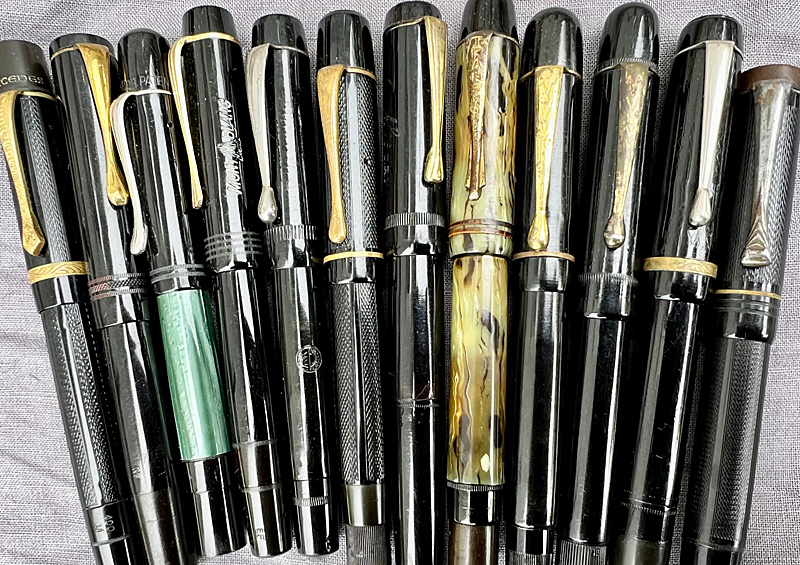
The most common colors of ink used for Wehrmacht identity documents were black and blue-black. These colors often appear washed-out or muted to some extent, this is likely at least in part due to the passing of time but modern inks marketed to artists and pen enthusiasts are likely to be more saturated-looking than the mass produced wartime stuff. I find that most modern inks look more realistic when diluted with water by fifty percent. “Iron gall ink” is made from iron salts and oak galls and was the standard ink used in Europe starting around the 12th century, this was used through WWII as well. The most remarkable thing about this ink is the way it marks the paper- it actually causes a chemical reaction with the cellulose in the paper to form a waterproof black mark. The chemicals that cause this reaction are colorless, the ink has an added coloring (usually blue) that allows you to see what you are writing as you write it but in a matter of seconds the color of the writing will actually noticeably change as the chemical reaction takes place. The result is a dark and totally indelible mark on the paper. I like to use iron gall inks to fill out the main entries in a Soldbuch on the first few pages. A reenactor’s Soldbuch is highly likely to get damp or even saturated after some period of field use and the waterproof iron gall ink ensures that the basic entries will remain legible. Iron gall ink is a period correct ink formulation and it creates a very realistic appearance. A caveat is that this ink is acidic, can be corrosive to metal, and has the risk of changing over time. This can harm fountain pens over time, so I do not use this in my vintage pens. I find that the appearance of dried iron gall ink can be very variable- again, a good thing.
By the time a Wehrmacht soldier left basic training, there would be many stamps in his Soldbuch. The Soldbuch was stamped when it was issued, it was stamped by a paymaster, the soldier was issued equipment and received immunization shots and those entries could have been stamped as well. From then on, every leave, every award, every rank promotion and equipment issue and unit transfer meant more entries and almost invariably more stamps as well. To fill out a Soldbuch of a recruit who had been assigned to a field unit, you will at a minimum need a round stamp for his training unit and a line rank stamp for an officer who signed to authorize entries in the book. You will also be wanting a stamp for the soldier’s current field unit, to stamp further entries like leaves and promotions. But to create a convincing illusion of something carried for years, you are going to want a lot of stamps for things like pay, equipment issues, hospitalizations and medical entries, and of course different rank stamps for the many various people who would have handled a Soldbuch over the course of a soldier’s military career. I offer three different sheets with many different stamps that are useful for nearly any Soldbuch project, I can also make any custom unit or rank stamp.
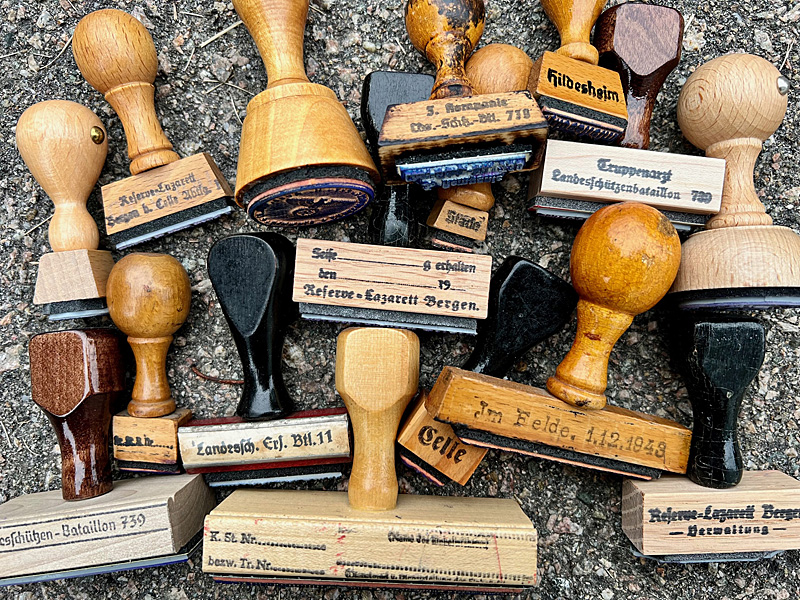
Once you have the basic equipment, you are going to want to add more accessories. Period-type stamp stands, pencils and pencil boxes, stamp pads, and other desk accessories are available. Old inkwells and ink bottles, blotters, staplers, paper clips and the like help add to a Schreiber impression and create a realistic-looking duty station. The possibilities of a wartime clerk’s writing desk are limited only by your imagination. Look for period-type boxes and containers to store and transport these items.
Eventually, you are going to want to get a typewriter. Wartime and pre-war German typewriters were finely and expertly built, and built to last. With some minor cleaning, many typewriters of the era will work as well as they did decades ago. New replacement typewriter ribbons are still being manufactured. I recommend looking for a typewriter with the correct “QWERTZ” German keyboard format. Every typewriter has a serial number, and for most manufacturers, the serial number lists have been published online, which makes it possible to determine the exact year a typewriter was manufactured. Nazi-era German typewriters with the special key to type the “SS” runic symbol are highly sought-after and can carry a hefty price tag, but other wartime and pre-war machines can be found relatively cheaply. I’ve got an article about getting a typewriter for reenactment.
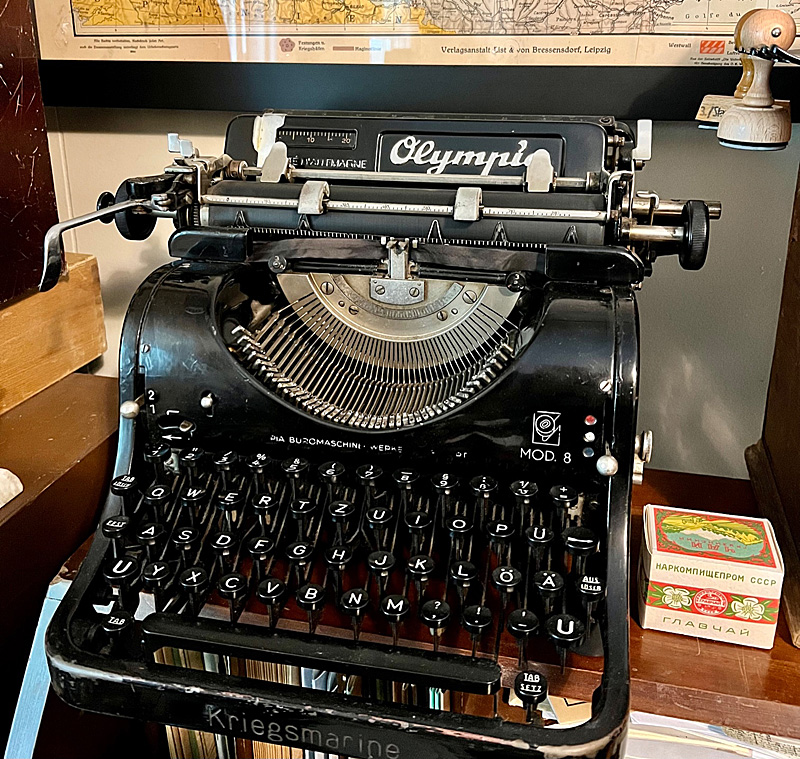
You will need paper too, of course, and I have an article about that as well.
A simple wooden table can be a perfect basis for a Schreibstube in a barracks or in the field. With regard to the work station, the original guidelines for the clerks working in a Kompanie Schreibstube stipulated that the work areas should be clean. The “Hilfsbuch für den Hauptfeldwebel” has this to say about “Clarity and Order in the Schreibstube”:
“All files, regulations, forms, and lists are organized in cabinets and kept under lock and key. Every item must have its place according to regulation, this must be known to every Schreiber.
With the clerks and their respective desktops one finds nothing more than:
The tools (pencil, stenographer notebook, etc.)
A folder for pending items.
An appointment calendar.
The folder for pending items has many compartments, in which the paperwork can be organized according to the priority of its completion. Nothing stays pending longer than absolutely necessary, it is then filed or destroyed.
Every clerk has an appointment calendar to record notes about work and events that cannot be dealt with immediately. The first clerk condenses this into an appointment calendar for the Kompanie.”
In reality of course these regulations were not always followed. In surviving wartime photos of Wehrmacht soldiers performing clerical tasks, some of the writing desks are very spartan and clean, others cluttered with papers and very messy. Looking at any given writing desk it may not be possible to say just what kind of work was being performed there, whether it was simply a place where an officer might deal with routine correspondence, or a duty station where a clerk might be filling out dozens of different documents every day. The appearance of a reenacted Schreibstube must necessarily be dictated partially by the scenario of a given event, and partially by the real demands of clerical work at that event. In general, a reenacted Schreibstube is not just a display to be seen, but is the place where a Schreiber does his duty and works on documents. This often necessitates having and using more stamps than may have been required by the historical role being portrayed. To fill out a Soldbuch, one might have to be a dozen different officers, a couple of paymasters, a doctor, a Hauptfeldwebel and a supply NCO. And of course filling out entries made by each of these people could require different pens and inks. Trying to dovetail the work being performed with the role being portrayed is something that can constantly be refined. At some events it may be possible to purely play the role of Kompanieschreiber and not worry about anything that would have been outside the normal duties of such a clerk. More often, one may be tasked with other kinds of responsibilities.
A Schreiber who has mastered making entries in a Soldbuch can move on to other documents. This link details all of the different documents that were completed and maintained by the clerks in a Kompanie Schreibstube. As mentioned above, it is unreasonable for a single person in a reenactment group to attempt to deal with all of this. A reenactment Schreiber has to focus on what makes sense for his role in his unit. In light of that, here are some additional types of documents that could be projects for a Schreiber in a reenactment group:
–Truppenstammrollenblatt: This is the unit roster, made up of pages in a binder.
-Wehrpass: This is an advanced project, a fairly extensive record held by the Schreibstube for each soldier in the unit, that detailed his military career.
-Feldpost: Mail was a huge priority in the German supply chain, second only to ammunition. Perhaps you could make some recreated letters to distribute, or supply stationery for reenactors to write letters, to which you would then apply postmarks as appropriate before passing the letters to an NCO who will hand out the day’s mail.
-Award documents: These can be part of a soldier’s personal paperwork and can also be used at events to recreate the bestowal of wartime awards.
With some creativity and imagination, you will come up with other paperwork that can augment your impression as well as the impressions of others in your group. Various passes and authorizations can be typed and stamped, correspondence of all kinds can be handled appropriately. Part of the fun of the Schreiber impression is that it is virtually impossible to know everything about every aspect of wartime paperwork. There is always something new to learn, some other detail to consider.